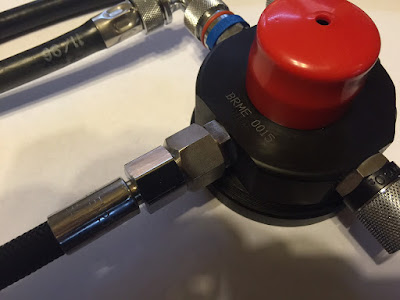So as we approach the end of our Drager Dolphin Project, we have decided to add some final upgrades to our test Dolphin. As we mentioned earlier, the Dolphin is strictly a mechanical rebreather, and there are no on-board electronics. So therefore, there is not much we can modify from the original design, except for the original (and optional) Drager Oxyguage.
 |
Drager Oxyguage
|
The Oxyguage was designed as a simple P02 display for the rebreather. In fact, it was so primitive at the time that many owners decided not to purchase it or simply didn't use it. The Oxyguage's P-Port contained an oxygen sensor which was connected/inserted to the inhalation counterlung. The P-Port and sensor were connected by a cable to a console with an LED display. The display would show the divers P02 at any given point during the dive, and also provide alarms if the P02 was too low or too high. Simple enough right? Yes, but extremely primitive by today's standards. The problem with the Oxyguage even then was that it didn't have a dive computer integrated into the electronics. The diver could always see his P02, and that was great (Always know your P02), but one still had to have a separate computer to track his nitrogen loading and 02 exposure. The issue there was that the inspired gas from the counterlung, was never the same as the mix contained the the cylinder. All dive planning was done based on the mix in the cylinder, and not what the diver was actually breathing from the counterlung. Enter 2016 and a more modern solution. To solve the problem, we needed to connect our Dolphin to our Shearwater Petrel computer via a cable connected to the P-Port. We contacted Martin our Dolphin expert at Tec Me in Germany, and he made us exactly what we needed. A cable with a P-Port connected to a Fischer plug. We placed an R-22D sensor into it an attached to directly to the Petrel''s Fischer port. Now we have the perfect solution. Real time P02, oxygen exposure, and N2 monitoring, plus the ability to switch the computer to our bail-out gas if needed.
 |
| Shearwater Computer and 02 Sensor |
Next, although our Dolphin was new in the box, it did not come with the original Drager 27cf cylinder, but we were able to find a suitable replacement. We decided on the Faber 27cf low pressure steel cylinder. The problem was that it contains a DIN valve, and does not directly connect to the M26 thread on the Dolphin's first stage. The dolphin is a German rebreather, and therefore the thread size is not compatible with the standard DIN connection we use today. Again, we looked to Martin at Tec Me for the solution. He sent us an M26 to DIN adapter, which was a perfect match.
And lastly, we needed to add a bailout system to the rebreather. As with any rebreather, The diver must have the ability to bailout to a known gas. That known gas it most cases is just plain air. We opted for a 13cf Luxfur Cylinder which mounts nicly to the side of the rebreather's cover. As For the bailout regulator, we went with Dive Rite regulators.
As fun as this project has been for me personally, to relive the Dolphin has wonderful. I hope you enjoyed this trip down rebreather memory lane.
Here is the completed Dolphin next to a few of our other rebreathers.
Visit our website at www.eliteprodive.com for more Drager Dolphin information and training





















